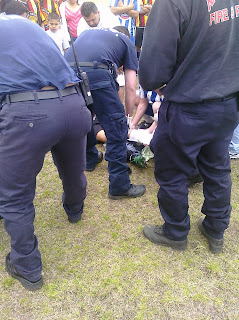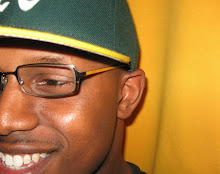...or just another day in the life of an Athletic Trainer!
This afternoon while attending Ben's usual Sunday soccer game (he participates in a Mexican League), we witnessed a pretty nasty injury to one of the opposing players. In the late second half, the score was 3-2 so both teams are battling; one team to tie the game, the other to win the game. Lauren P. (also another emergency responder) and I are sitting in upper part of the stands when these two teammates both go for the ball. I'm presuming they didn't see one another. One teammate goes to kick the ball, but instead, kicks his own guy along the side of his lower leg. The teammate then proceeds to fly about 4ft. in the air, inverts head-over-heel, and lands on his back. However, while in the air, the kids' foot points outwards, as if it was broken in half -- just dangling there, prior to him slamming back into the ground. Lauren and I both have an "Oh S__t!" moment. Well, her's was more like a "Oh my!," but still we both had sudden reactions from the sight of the grossly deformed foot.
At that moment I run onto the field to check on the athlete. He is visibly hurt and in pain, yet calm. Some of the players begin to surround the scene. I survey the athlete and his foot does not appear to be in any unnatural position. In fact, it is pointed straight and not out to the side, like it was when upon initial contact. The player is on his side, as pictured below, and reaches down to grab for his leg. Upon closer inspection, there appears to be a bulge along the lateral malleous, or outside ankle, apparently the site of injury.
There were over 300+ Spanish speaking individuals (a language which I do not speak fluently) so I motioned to one of the persons standing by for his shirt, or jacket, to cover up the foot, for fear that the player would see it and go into shock. It was just a precautionary measure, but luckily, the player was very calm. He squirmed and groaned occasionally, but overall, he was very calm.
By now, Ben and I are both at the scene, some 1.5 minutes into the ordeal, and the the players' cousin, is dialing 911, but no one (out of the 300+ people out there) knew exactly where we were!

Meanwhile, Ben begins to palpate the players ankle and lower leg feeling for deformities. I report to him what I saw, and he continues his inspection. By now, everything has stopped (on both fields) and everyone has gathered around, so I step back and try to restore control, making space for Ben to work and creating a path for the ambulance. The cousin on the phone finally communicates to the authorities that we are at a park off the loop, that when I say "Near the expo center," which would hopefully give them a better idea of our location.
Ben is busy checking for breaks in continuity, checking pulses, and making sure everything is intact, while we wait for the ambulance to arrive. He is also asking questions about relevant sounds and sensation, all through the cousin who is translating every word. At this point, the only thing we could do is manage the scene, keep the athlete as comfortable as possible (placing a rolled jacket underneath his head), monitor his consciousness making sure he's not slipping into shock (he said he didn't want the jacket we offered to keep him warm), and wait for the Emergency Personnel to arrive.
It was at this point where I pulled out my phone and began to take pictures, and Ben instructs one of the persons standing by to flag down the ambulance once it arrives. They got there quickly in under 12-13 minutes.
Emergency personnel working to remove the shoe.
Ben (blue white stripes) assisting with the care of the athlete. A closer look reveals the position of the splinted foot, wrapped in what appears to be a rigid "L" shape splint that covers the foot posteriorly, with a soft cushion material protecting it anteriorly and laterally, which had the appearance of an Ace bandage.
Once the players shoe was removed, he was lifted and boarded onto the stretcher and placed into the ambulance. And 5 minutes later, the game resumed. Ben's team ended up losing 3-2.
Video of Ben's inspection and communicating with the cousin, right before the ambulance arrives.
My impressions of what happened, and over reflection with Ben, is that the guy suffered a left leg distal fibular fracture, evidenced by the 90 degree angulation his foot presented with while he was in the air, but possibly upon impact with the ground, his foot shifted to its normal position, although by normal, I mean it was no longer pointed outwards. During Ben's inspection he noticed some discontinuity over the lower fibular shaft, and noticeable deformity, but it was a closed-fracture, or there was no skin breakage.







